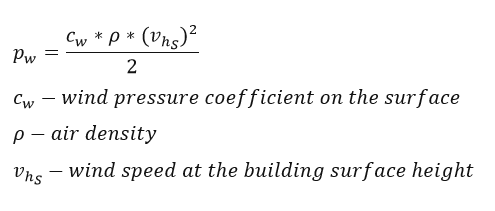Dear all,
Are there ways to deduce the infiltration rate based on the facade wind pressure coefficient? Given a glazing ratio and construction quality.
So far I am trying to digest: http://journals.sagepub.com/doi/pdf/10.1177/0143624413499354
where they use DOMVENT3D to get the following
cheers,
Olivier
@OlivierDambron
This is also what I am trying to achieve as well. I believe we should have standard template with Butterfly where we place building and then we run CFD for 1-32 orientations, ie. 8 (0.0 45.0 90.0 135.0 180.0 225.0 270.0 315.0) wind orientation and then we have more accurate pressure coefficients for all external aperture.
As standard output we should get .csv, .txt file with
Suggested Format
-
No. of wind directions: The number of wind directions for which pressure coefficients are specified (in the range 1 to 32).
-
Wind directions: The wind directions for which pressure coefficients are specified, in degrees clockwise from north in the range 0 to 360.
-
Space ID, Surface ID: The ID of the zone and surface for which wind pressure coefficients are specified.
-
Wind pressure coefficients: The wind pressure coefficients for the specified surface, for each wind direction specified on the first line.

1 Like
@MichalDengusiak
For a specific sample case we could easily build the parametric definition although the current wind tunnel in Butterfly implies that for each rotation Openfoam will need to remesh which is not very efficient overall.
The other way as @TheodorosGalanos once suggested is to use a cylindrical wind tunnel.
Regardless of the level of accuracy, how to link the pressure coefficients on the external aperture to the actual intensity of the infiltration?
1 Like
@OlivierDambron I’m just following along here, and don’t have any CFD experience but can you get the wind pressure at each zone surface? Then I believe we can easily solve for velocity and I believe multiply velocity by window area and any sharpness coefficients to get cubic flow, and from there derive ACH or whatever infiltration unit you need.
1 Like
Hi @SaeranVasanthakumar getting pressure is simple enough, you simply assign probes at the center of the openings, usually on or near the surface itself (examples of applications, some while running the simulation https://cfd.direct/openfoam/user-guide/graphs-monitoring/).
Another a bit more involved way is to use the actual (.stl) surface of each opening from Rhino and sample values over it (eg. average pressure, velocity, etc. over the surface). Or you can use the same technique to sample directly volumetric flow (if this is an actual opening where inflitration happpens (see 6.2.1.2 here).
Kind regards,
Theodore.
1 Like
@TheodorosGalanos
I have to admit the formula for infiltration I was thinking of is a bit more complicated then I recalled, and may be overcomplicating the issue. It’s the formula used by DesignBuilder to calculate infiltration rate[1].
And on second thought, manually calculating infiltration rates may be unnecessary. EnergyPlus has an option to manually input Wind Pressure Coefficients as part of its AirflowNetwork object, which in turn calculates envelope leakage rates. While the AirflowNetwork isn’t implemented in Honeybee yet, I believe Chris/Anton is planning on doing it, and that may be a cleaner way of integrating the CFD wind pressure coefficients and infiltration rates. I’m sure others who have more expertise with EnergyPlus can weigh in on this.
[1] https://ac.els-cdn.com/S1876610217329661/1-s2.0-S1876610217329661-main.pdf?_tid=b578659b-a762-4919-bcc4-d98e9d85e345&acdnat=1523079072_656752c8f9d42d0637369710f2a3c487
hi @SaeranVasanthakumar and @TheodorosGalanos
I had an old grasshopper definition which I use to calculate multiple wind directions for a given geometry. I have readapted the bits and pieces into the current outdoor airflow sample case of butterfly. It’s a crafty way of doing it but it works so far.
Please have a look when you have some time and let me know if it all makes sense to you.
08042018_MultiDir_outdoor_airflow.gh (2.8 MB)
There is still an issue here when using Ladybug_Fly, all the meshing processes followed one another but some solutions didn’t run.
I will try another example with reading the pressure values on the fenestration area.
4 Likes

